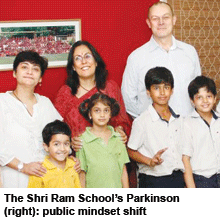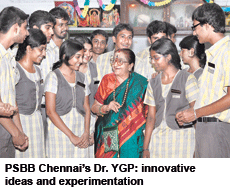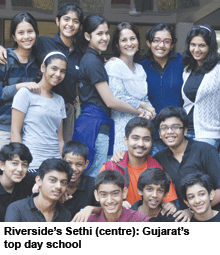This year the podium order of 2010 has been rearranged with The Shri Ram School, Delhi which was ranked joint second with Mallya Aditi, Bangalore last year, being restored to its 2008 and 2009 top table position
 Among india’s top-ranked day schools, there’s a neck-and-neck annual race for premier position. For the second consecutive year, the Cathedral and John Connon School, Mumbai (CJCS), The Shri Ram School, Delhi (TSRS) and Mallya Aditi International School, Bangalore (MAIS) have been confirmed as the country’s most respected day schools, except that this year the podium order of 2010 has been rearranged with TSRS which was ranked joint second with MAIS last year, being restored to its 2008 and 2009 top league table position. CJCS has been pushed to second position and MAIS to third, though there’s very little to separate them in terms of aggregate score. 2,044 parents, teachers, principals and educationists countrywide, constituted the sample base this year.
Among india’s top-ranked day schools, there’s a neck-and-neck annual race for premier position. For the second consecutive year, the Cathedral and John Connon School, Mumbai (CJCS), The Shri Ram School, Delhi (TSRS) and Mallya Aditi International School, Bangalore (MAIS) have been confirmed as the country’s most respected day schools, except that this year the podium order of 2010 has been rearranged with TSRS which was ranked joint second with MAIS last year, being restored to its 2008 and 2009 top league table position. CJCS has been pushed to second position and MAIS to third, though there’s very little to separate them in terms of aggregate score. 2,044 parents, teachers, principals and educationists countrywide, constituted the sample base this year.
“At a deeper level, our consistently high ranking of the past four years is indicative of a shift in the public mindset in favour of quality holistic education. Parents are now well aware that the quality of teachers and their continuous in-service training and development is critical to academic excellence. Therefore it’s very satisfying that TSRS has been ranked the country’s No. 1 school on the parameters of teacher welfare and development, and competence of faculty. Moreover, there’s widespread awareness that we involve parents in the education of children to whom our highly-trained teachers pay personal attention. This explains our top ranking under the parameter of parental involvement. Logically, all this plus our high ranking under the parameters of sports, co-curricular and community service education should result in a top ranking under academic reputation. But evidently the public hasn’t quite made this connection. Nevertheless I won’t complain,” says Mark Parkinson, former principal of Oxford International School, Dhaka and director of the two Shri Ram Schools in Delhi and Gurgaon since 2007.
While the top three slots have been monopolised by the usual suspects, further down the day school league tables within the Top 10, there’s been considerable churn. Chennai’s Padma Seshadri Bala Bhavan School (PSBB), promoted in 1958 by the grande dame of school education in Chennai, Dr. Y.G. Parathasarathy, has vaulted to No. 3 (from No.7 last year and 22 in 2009), a ranking it shares this year with Mallya Aditi, Bangalore. Also included among the country’s Top 5 day schools this year is Delhi’s Vasant Valley School promoted by India Today publisher-editor Aroon Purie in 1990 and ranked No. 4 (9 in 2010 and 17 in 2009).
 “We are pleased to learn that we have been ranked No.1 in south India and third nationally. It’s also gratifying to witness that PSBB has been moving up the national league table every year since 2009. This is the result of introducing innovative ideas and experi-ments in teaching/learning, according high importance to values-based education and expanding the range of extra and co-curricular activities offered to our children. We also owe our steady progress to our committed teachers who put in a lot of hard work and constantly update their knowledge. This is reflected in the No.1 rating we have received under the parameter of leadership/ management quality” says Dr. Parathasarathy, the celebrated dean and director of the PSBB group of schools.
“We are pleased to learn that we have been ranked No.1 in south India and third nationally. It’s also gratifying to witness that PSBB has been moving up the national league table every year since 2009. This is the result of introducing innovative ideas and experi-ments in teaching/learning, according high importance to values-based education and expanding the range of extra and co-curricular activities offered to our children. We also owe our steady progress to our committed teachers who put in a lot of hard work and constantly update their knowledge. This is reflected in the No.1 rating we have received under the parameter of leadership/ management quality” says Dr. Parathasarathy, the celebrated dean and director of the PSBB group of schools.
The next four slots of the 2011 league table of the country’s most admired day schools are filled by several national capital institutions which have been hardy perennials in the EW-C fore India’s Most Respected Schools surveys ab initio. Springdales, Dhaula Kuan; Sanskriti, Chanakyapuri; Delhi Public School, R.K. Puram, and Mother’s International are all tied at 6th place with DPS, R.K.Puram being consistently rated No.1 under the parameter of academic reputation since 2007.
Nevertheless India’s Top 10 day schools are well distributed geographically with Vidya Niketan Academy, Bangalore moving up to No. 7 (10 last year), Gitanjali School, Hyderabad ranked No. 8 together with Smt. Sulochanadevi Singhania School, Thane (Mumbai) which has risen spectacularly in public esteem vaulting from No. 36 last year. At No. 9 are Mumbai’s venerated Campion and Bombay Scottish, who have yielded some ground in this year’s league table.
Completing the Top 10 list are Step by Step, Noida (10) and the quasi-alter-native The Valley School, Bangalore, which subscribes to the education nostrums of teacher-seer J. Krishnamurti (1895-1986) who promoted Rishi Valley School, Chittoor (ranked India’s top boarding school this year — see p. 102), and has made a spectacular leap in public perception rising from No. 61 in 2010 to No.10 this year. Read together with the inclusion of the hitherto unranked Centre for Learning, Bangalore within the Top 20 (and the rise to the top of Rishi Valley School in the boarding school league table), this is indicative of a distinct shift in informed public opinion in favour of alternative-style new age schools with eco-friendly, values-based education orientation.
Among other schools which have made an entry into the Top 20 are Springdales, Pusa Road (Delhi); Modern High, Kolkata; DAV, Sector 14, Gurgaon and Hiranandani Foundation School, Mumbai (from 47 to 19), while the Noida-based Amity International and Modern School, Barakhamba Road, Delhi have improved their ranking within the Top 20.
Newly promoted schools in the fast-developing satellite cities of Delhi such as Gurgaon and Ghaziabad are quickly establishing excellent reputations for themselves. Thus DPS, Ghaziabad has vaulted into the Top 30 to be ranked 22 this year (39 last year); the Heritage School, Gurgaon to 23 (86) and Salwan Public, Gurgaon to 24 (80).
Also ranked among the Top 30 are Sishya, Chennai (21) and Inventure Academy, Bangalore (21) which despite its relative new vintage (estb.2005) has consolidated its ranking above the garden city’s hitherto highly regarded Bishop Cotton Boys (38) and Bishop Cotton Girls (47), both of which had recently been embroiled in unseemly rows between their governing boards and principals, resulting in the exit of the latter. The examples of these two more than a century old schools and of La Martiniere for Boys, Kolkata (30) which suffered a widely publicised student suicide allegedly due to extreme corporal punishment — all ranked within the Top 10 in 2008 and 2009 — dramatically illustrates how institutional reputations built over centuries can be rapidly ruined.
Among other primary-secondaries which have improved their public image and zoomed into the list of India’s Top 30 day schools are the formerly unranked Mirambika, Delhi (27), DAV, Chandrasekharpur, Bhubaneswar (28) and Bombay International (29).
Other institutions which have improved their ratings to rank among India’s Top 50 day schools are Lotus Valley International, Noida ranked 32 (cf. 49 last year); Carmel Convent, Chandi-garh at 34 (43); Ahlcon International, Delhi which has zoomed to 38 (67) and Strawberry Fields, Chandigarh (unran-ked last year) to 40. Blue Bells, Delhi has also risen sharply in public esteem to be included in the Top 50 being ranked 41 (93) as have Montfort School, Delhi at 46 (70) and Tagore International, Delhi at 48 (95). This year’s ranks 30-50 list also includes several ‘fallen angels’ including National Public School, Indiranagar, Bangalore ranked 34 (cf. 5 in 2010); SBOA (State Bank of India Officers Association) School and Junior College, Anna Nagar, Chennai at 41 (25) and St. Xavier’s Collegiate, Kolkata 40 (13).
Yet while they are important from the viewpoint of assessing the national reputations of day schools inter se, the national league table is of limited utilitarian value as regional, civic and local reputations are of greater import for day scholars whose parents prefer to enrol them closer to home. Therefore the regional ranking (p.72) tends to be of greater practical use and arguably more accurate, because the sample respondents are inevitably more knowledgeable about local primary-secondaries than those farther afield.
 Thus, for instance, while it’s ranked No.10 in the national league table, Step by Step, Noida is ranked No. 5 in North India and No.1 in Uttar Pradesh with the latter ranking of greater significance to parents and students in UP. Similarly the hitherto unfancied Smt. Sulochan-adevi Singhania School, Thane has emerged as Mumbai’s most respected day school after Cathedral and John Connon ranked second all-India.
Thus, for instance, while it’s ranked No.10 in the national league table, Step by Step, Noida is ranked No. 5 in North India and No.1 in Uttar Pradesh with the latter ranking of greater significance to parents and students in UP. Similarly the hitherto unfancied Smt. Sulochan-adevi Singhania School, Thane has emerged as Mumbai’s most respected day school after Cathedral and John Connon ranked second all-India.
Likewise the all-India and especially the regional league tables offer school managements and educators a rich trove of information. Thus further investigation of the national league table reveals that Gitanjali School, Hyderabad (estb.1985) is the No. 1 day school in Hyderabad and the southern state of Andhra Pradesh (pop.85 million), no mean achievement. Likewise the Riverside School, ranked a modest No. 13 nationally is the No. 1 day school of Ahmedabad and the western seaboard state of Gujarat (pop. 60 million); DAV, Chandrasekharpur is the No. 1 day school of Orissa (pop. 42 million); St. John’s High is No.1 in Punjab, and City Montessori, Gomti Nagar, ranked No.50 nationally is Lucknow’s most respected day school and fifth in Uttar Pradesh — India’s most populous state (200 million).
Similarly, further data mining reveals that Modern High School for Girls is the most respected day school of Kolkata and West Bengal (pop. 91 million); Hansraj Public, Panchkula in Haryana (pop. 25 million); Pallikoodam School is numero uno in Kerala (pop. 33 million) and Birla Public, Pilani in Rajasthan while Sharda Mandir, Panjim ranked No. 87 nationally is No.1 in Goa. The more assiduous can also work out city and even district ranking through elementary investigation, which information is not included in this issue of EducationWorld due to paucity of space and time.
Last year, the list of day schools rated and ranked aggregated 241. This year it is 75 percent longer and against the 143 ranks awarded in 2010, 176 schools are rated and ranked countrywide. The continuously rising number of primary-secondary schools offering themselves for rating and ranking, or being recommended by EducationWorld because of their growing reput-ation, is a positive develop-ment in the national interest. Quite obviously, India’s 321 most well-known primary-secondaries are becoming incrementally conscious of the combination of qualities or parameters of excellence required for transforming good into excellent schools and which are necessary to prepare children to avail the full benefit of higher education.
That’s why a growing number of principals and managements are stepping forward to be assessed and ranked with an eye on besting competition and winning golden opinions from the discerning public, which is only too aware that unless teaching-learning and standards of education in K-12 education nationwide are raised to international norms, statements of intent about reaping India’s demographic dividend will remain empty rhetoric.
India's best day schools league table /userfiles/India's Best Day Schools league table.pdf
Day Schools: Regional league tables userfiles/Day schools Regional league tables.pdf
Parameters of Excellence: India's Top 10 Day Schools /userfiles/Parameters of Exellence India's Top Day Schools.pdf